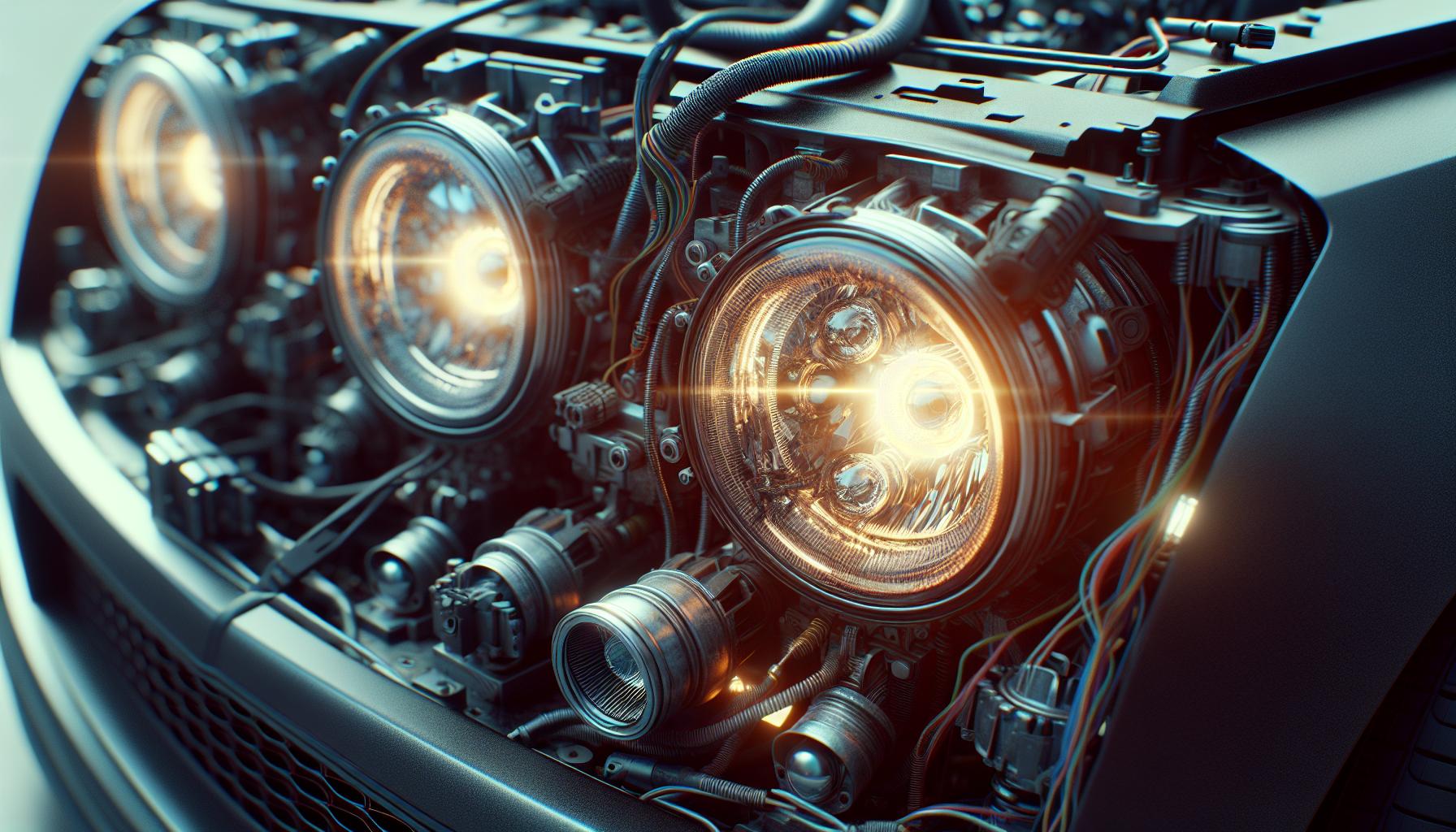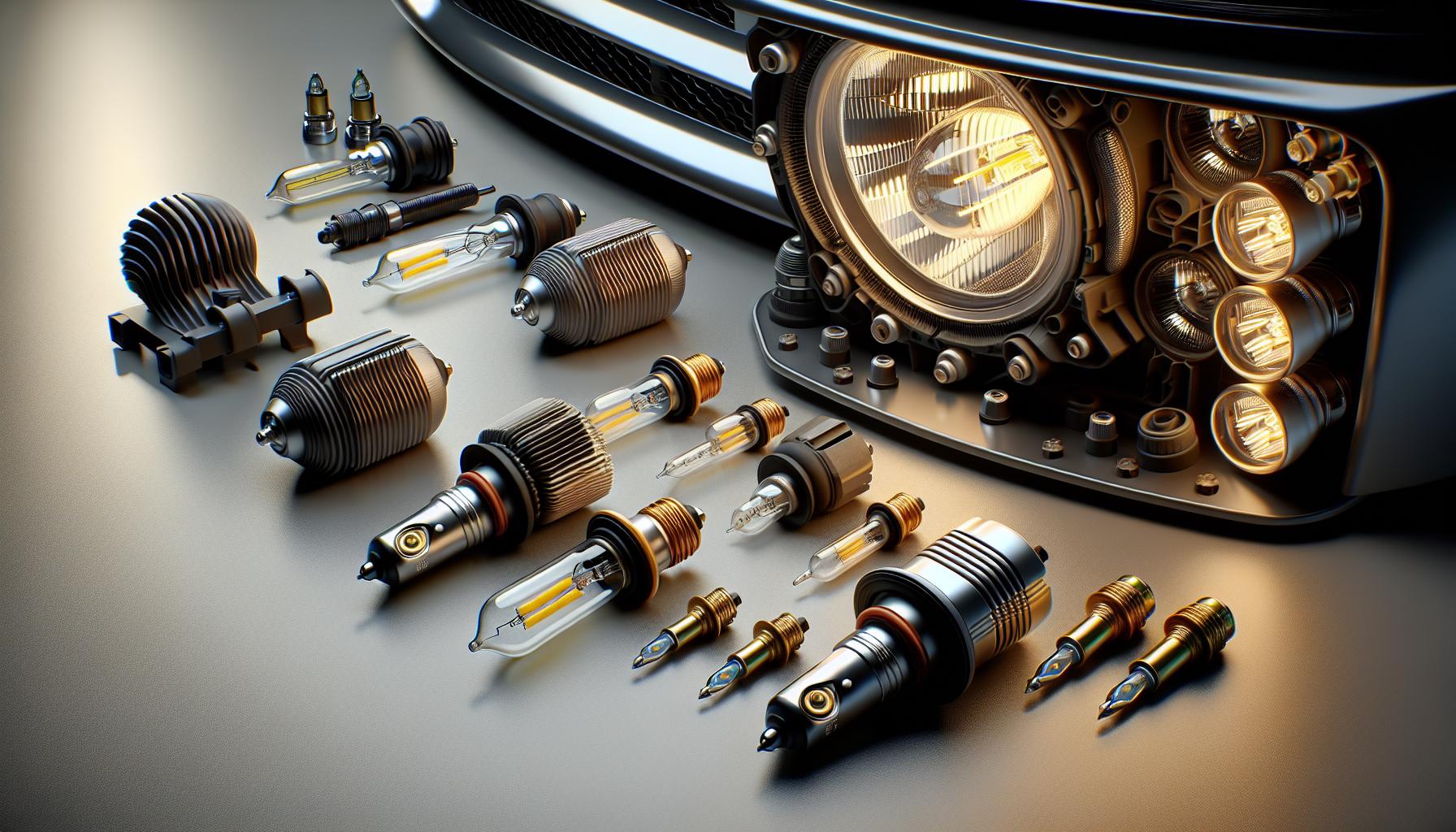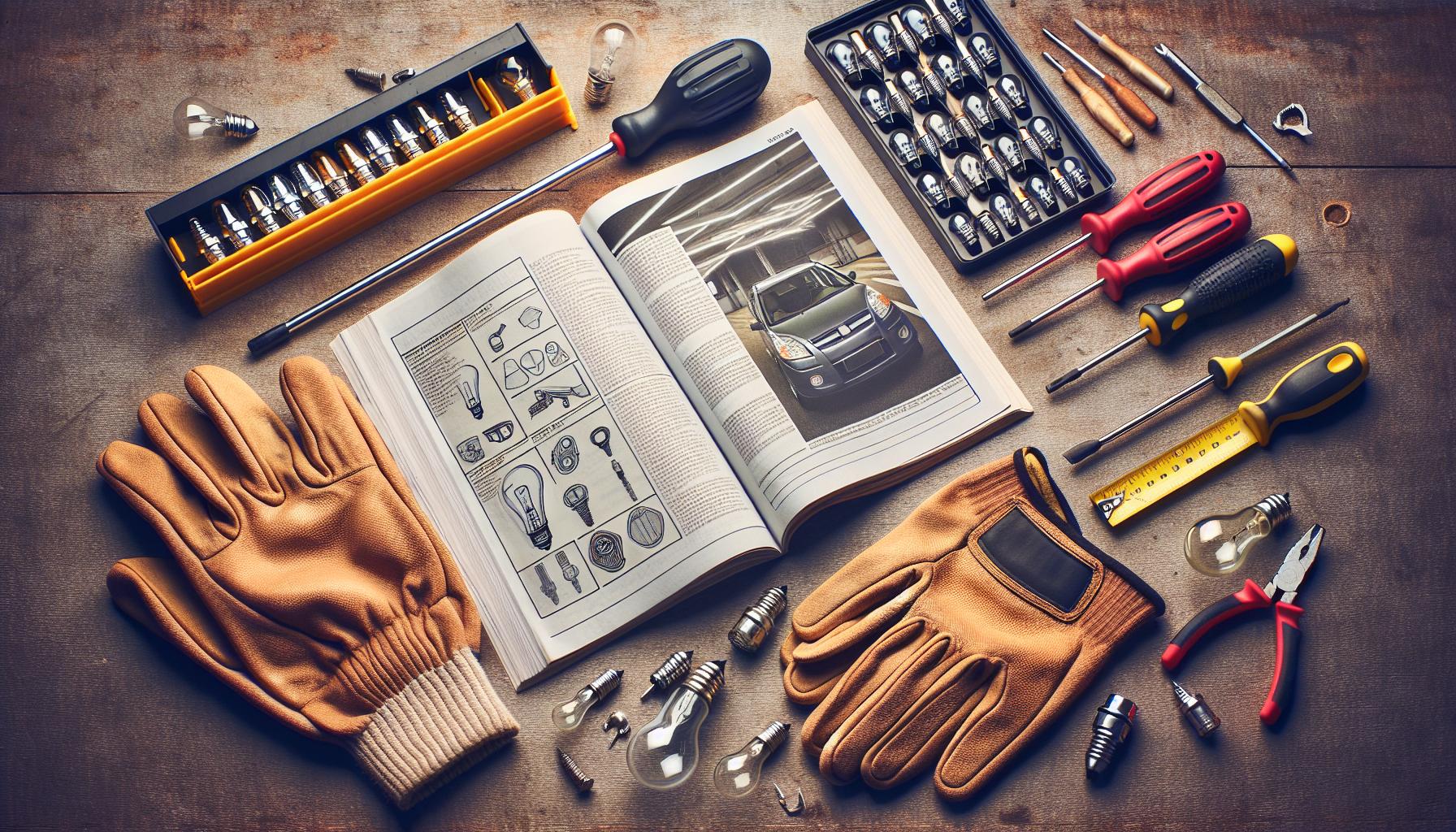Ever found yourself squinting through the dark because your car’s headlights just aren’t as bright as they used to be? You’re not alone. Keeping your car’s light bulbs in tip-top shape is crucial for safe driving, but it’s often overlooked until you’re left in the dark.
Knowing when to swap out those bulbs isn’t just about visibility—it’s also about staying on the right side of the law and ensuring your safety on the road. Let’s shed some light on the signs that it’s time for a change and how to stay ahead of the game.
Importance of maintaining car light bulbs
Maintaining your car’s light bulbs is crucial for several reasons. Visibility is arguably the most important factor; your headlights, brake lights, tail lights, and turn signals are your main line of communication with other drivers, especially during night-time driving or adverse weather conditions. Well-maintained lights ensure others see your vehicle clearly, drastically reducing the risk of accidents.
Aside from safety, there are legal requirements to consider. Driving with a non-functioning light bulb can result in fines or even points on your driving record. In most states, laws require that specific lights be functioning properly at all times. This isn’t just about headlights—brake lights and turn signals are also under scrutiny.
Here’s what you need to keep an eye on to stay ahead:
- Headlight Brightness: Over time, headlights can dim. This gradual change often goes unnoticed. If your lights seem less bright than they used to be, it might be time for a change.
- Damage or Discoloration: Bulbs can become damaged or the lenses can discolor, reducing effectiveness. Regularly clean your car’s light covers and inspect for signs of wear.
- Flickering: If a light starts flickering, this is a clear signal that the bulb is reaching the end of its life.
Remember, headlights are not just about seeing; they’re also about being seen. Even during the day, running lights can increase your visibility to other drivers. As a DIY enthusiast and lighting aficionado, you know that something as simple as a bulb change can significantly enhance the performance of your vehicle’s lights. Choosing high-quality bulbs and keeping them in good condition is a small, yet impactful, way to ensure your safety and compliance with road laws. Regular checks and maintenance should form part of your routine vehicle care. After all, car lights are an integral feature that requires as much attention as any other part of your vehicle.
Signs that indicate it’s time to change the bulbs
Your car’s light bulbs are crucial components that dictate not only your vehicle’s visibility but also affect how other drivers perceive your presence on the road. Despite their resilience, they don’t last forever, and knowing when to replace them can save you from potential hazards.
Dimmed Brightness: If you’ve noticed that your headlights are not as bright as they once were or if road signs are harder to read at night, it’s a sign that your headlights may be losing their potency. A dim headlight doesn’t just affect your visibility; it also makes it harder for others to spot you.
Discoloration: Over time, the clear plastic cover of your headlights may yellow or become foggy due to UV exposure and other environmental factors, which can significantly reduce light output. While this is more of a headlight cleaning or restoration issue, it affects how effective your light bulbs are.
Flickering Lights: A flickering bulb is a telltale sign that it’s on its last legs. Flickering can indicate a faulty connection or that the bulb’s filament is about to fail. Ignoring this warning could result in a bulb giving out at an inopportune moment.
After a Crash or Collision: Even a minor fender bender can damage your car’s light bulbs or their housing. It’s prudent to check all your vehicle’s lights after any collision and replace any bulbs that show even the smallest sign of damage.
Keep in mind the type of bulb your car uses. Halogen bulbs typically have a lifespan of around 1,000 hours, whereas HID (High-Intensity Discharge) bulbs can last up to 2,000 hours, and LEDs can run for an impressive 25,000 hours or more.
Here’s a quick comparison of bulb types and lifespans:
| Bulb Type | Average Lifespan (Hours) |
|---|---|
| Halogen | 1,000 |
| HID | 2,000 |
| LED | 25,000+ |
« When Did Light Bulbs Become Common in Homes? The Electrifying History
How Often to Replace Light Bulbs: Maximize Bulb Life & Brightness »
Remember, apart from natural wear and tear, driving habits and conditions play a role in how often you’ll need to change your car light bulbs. Vigilance and regular checks are your best defense against being caught off guard by a burnt-out bulb.
Understanding the different types of car light bulbs
As you dive deep into the world of car maintenance, you’ll find that not all light bulbs are created equal. Each type of bulb has its own set of characteristics, advantages, and lifespans that you’ll need to consider when planning for replacements.
Halogen Bulbs
Halogen bulbs have been the standard in car lighting for years. They’re affordable and readily available, making them a popular choice for many drivers. These bulbs use a tungsten filament mixed with halogen gas, producing a bright white light. However, over time, halogen bulbs dim due to filament wear; therefore, you should keep an eye on their performance.
LED Bulbs
Longevity and efficiency are the hallmarks of LED bulbs. They’re a superb choice if you’re looking for durability and less frequent changes. LED bulbs can last up to 25,000 hours, significantly outperforming their counterparts. They also come in a variety of colors and temperatures, providing you with more options to customize your car’s appearance.
HID (High-Intensity Discharge) Bulbs
HID bulbs, also known as Xenon bulbs, produce light through an arc between two electrodes. They are much brighter than halogen bulbs and have a whiter light, which improves visibility. HID bulbs also have a longer lifespan, but they come with a higher price tag.
Here’s a quick comparison of the average lifespans:
| Type | Average Lifespan (hours) |
|---|---|
| Halogen | 1,000 |
| LED | 25,000 |
| HID/Xenon | 2,000 |
Owning to their different technologies, these bulb types also vary in energy consumption and impact on your car’s electrical system. While LEDs draw less power and are easy on the system, HID bulbs might require a ballast for operation.
Remember, the right choice of bulb isn’t just about brightness or lifespan; it’s about ensuring consistent and reliable illumination whenever you’re behind the wheel. Whether you’re tackling a DIY project or simply changing a burnt-out bulb, understanding these variations can help you make an informed decision. Don’t forget to also consider external factors like driving conditions and weather, as they too can affect your bulb’s performance over time.
How often should you change car light bulbs?
When you’re juggling the demands of daily life, keeping tabs on your car light bulbs might not be at the forefront of your mind. Yet, understanding the right time to replace your car bulbs is crucial for your safety and others on the road.
Typically, car light bulbs should be inspected every year and replaced every few years, but this isn’t a one-size-fits-all situation. Remember, driving conditions and bulb type significantly influence bulb lifespan. If you often drive at night or through harsh weather, you might find yourself replacing bulbs more frequently.
Here’s a quick rundown:
- Halogen bulbs: They’re the old faithful of car lights, with a life expectancy of about 1,000 hours.
- LEDs: These newer tech wonders can shine bright for an impressive 15,000 to 20,000 hours.
- HID bulbs: Sitting in the middle, HIDs typically last between 2,000 and 3,000 hours.
Given these averages, you’ll generally want to replace your halogen bulbs every couple of years, assuming normal driving conditions. LEDs and HIDs have longer lifespans, so you’ll change them less frequently, but don’t get complacent! Always keep an eye out for any signs of dimming or color changes.
It’s also not just about time. If you hit a major pothole or experience a collision, give those bulbs a check even if they’re new. The impact can damage the filament or bulb components, leading to premature failure.
Have you considered upgrading? Switching from halogen to LED could reduce how often you’re up close and personal with your car’s headlight assembly. Plus, driving a car with LEDs could mean a more reliable light source, enhancing visibility for every journey you take.
While there’s no strict rule dictating an exact replacement schedule, being proactive and mindful of these guidelines will ensure you’re never left in the dark. Remember, your car light bulbs, much like the headlights they sit in, are your eyes on the road at night. Let them shine bright, let them light your way safely, and they’ll serve you well until it’s time for a refresh.
Tips for changing car light bulbs
When you’re ready to replace your car’s light bulbs, there’s a bit more to it than just buying new ones and popping them in. Here’s how to do it right.
First, always check your vehicle’s manual. Your manufacturer knows your car best and they will recommend the appropriate bulb type. Straying from this can lead not only to improper illumination but can also damage your car’s electrical system.
Next, consider wearing gloves when handling the bulbs. The oils from your hands can shorten the lifespan of the bulbs, especially halogens, by creating hot spots. This is less of an issue with LEDs or HIDs, but it’s still good practice.
Before you start, make sure you have the right tools on hand, usually just a screwdriver, but sometimes you need a specialized tool, which should be outlined in your vehicle’s manual. Safety is key, so ensure your car is off with the lights switched to the ‘off’ position. Also, let the bulbs cool down if they were on recently to avoid burns.
Here’s a tip that’s often overlooked: replace your bulbs in pairs. Even if only one bulb is out, the other is likely not far behind. Plus, this maintains even illumination for your safety and the safety of others on the road.
Bulbs can be delicate, so be gentle when removing and installing them. Don’t force a bulb into place; if it’s not fitting easily, double-check you have the correct bulb and you’re aligning it properly to the holder.
When you’ve got your new bulbs in, test them before getting on the road. Turn on your headlights and blinkers to ensure everything is working as it should be. Remember, lighting not only helps you see but also helps others see you.
By following these guidelines, you’ll have a seamless and successful bulb change, which means better visibility for safer driving. Now that you’ve got the know-how, your car’s lighting will be in top-notch condition for those night drives and foggy morning commutes.
Conclusion
Remember, keeping your car’s light bulbs in top condition isn’t just about following a set schedule—it’s about being alert to the signs of wear and taking action to ensure you’re always safe on the road. Whether it’s after an unexpected event like a collision or simply noticing a change in light quality, you’ve got the know-how to make the right call. With the right tools and a bit of care, you’ll keep your visibility clear and your journeys bright. So grab your gloves, check your manual, and when the time comes, you’ll be ready to shine a light on the road ahead. Safe driving!
Frequently Asked Questions
When should I consider changing my car light bulbs?
You should change your car light bulbs if you notice signs like dimmed brightness, discoloration, or flickering. It’s also wise to inspect them after a crash or collision.
Why is it important to maintain car light bulbs?
Maintaining car light bulbs is crucial for visibility and safety while driving, ensuring you can see the road clearly and other drivers can see you.
How do I choose the right bulb type for my vehicle?
Check your vehicle’s manual for the recommended bulb type or consult with an auto parts store to ensure you choose the correct bulb for your car.
Is it necessary to wear gloves when changing car light bulbs?
Yes, it’s advisable to wear gloves when changing car light bulbs to avoid getting oils from your skin on the bulbs, which can damage them.
Should I replace my car light bulbs in pairs?
It’s a good practice to replace car light bulbs in pairs to ensure both lights have equal brightness and lifespan.
How do I ensure I’ve installed the new bulbs correctly?
After installing new bulbs, be gentle and make sure they’re secure. Always test the new bulbs before driving on the road to confirm they’re working properly.





